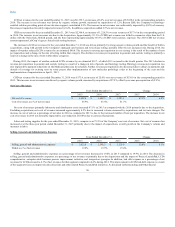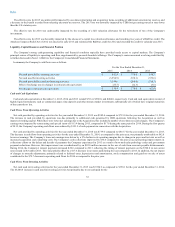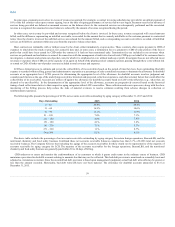LabCorp 2015 Annual Report Download - page 58
Download and view the complete annual report
Please find page 58 of the 2015 LabCorp annual report below. You can navigate through the pages in the report by either clicking on the pages listed below, or by using the keyword search tool below to find specific information within the annual report.
Index
LCD recognizes revenue for services rendered when the testing process is complete and test results are reported to the ordering physician. The sales are
generally billed to three types of payers – clients, patients and third parties such as MCOs, Medicare and Medicaid. For clients, sales are recorded on a fee-
for-service basis at the Company’s client list price, less any negotiated discount. Patient sales are recorded at the Company’s patient fee schedule, net of any
discounts negotiated with physicians on behalf of their patients, or fees made available through charity care or an uninsured patient program. LCD bills third-
party payers in two ways: fee-for-service and capitated agreements. Fee-for-service third-party payers are billed at the Company's patient fee schedule amount,
and third-party revenue is recorded net of contractual discounts. These discounts are recorded at the transaction level at the time of sale based on a fee
schedule that is maintained for each third-party payer. The majority of the Company’s third-party sales are recorded using an actual or contracted fee
schedule at the time of sale. For the remaining third-party sales, estimated fee schedules are maintained for each payer. Adjustments to the estimated payment
amounts are recorded at the time of final collection and settlement of each transaction as an adjustment to revenue. These adjustments are not material to the
Company’s results of operations in any period presented. The Company periodically adjusts these estimated fee schedules based upon historical payment
trends. Under capitated agreements with MCOs, the Company recognizes revenue based on a negotiated monthly contractual rate for each member of the
managed care plan regardless of the number or cost of services performed.
CDD recognizes revenue either as services are performed or products are delivered, depending on the nature of the work contracted. Historically, a
majority of CDD’s net revenues have been earned under contracts that range in duration from a few months to a few years, but can extend in duration up to
five years or longer. CDD also has committed minimum volume arrangements with certain clients. Underlying these arrangements are individual project
contracts for the specific services to be provided. These arrangements enable CDD's clients to secure its services in exchange for which they commit to
purchase an annual minimum dollar value of services. Under these types of arrangements, if the annual minimum dollar value of service commitment is not
reached, the client is required to pay CDD for the shortfall. Progress towards the achievement of annual minimum dollar value of service commitments is
monitored throughout the year. Annual minimum commitment shortfalls are not included in net revenues until the amount has been determined and agreed to
by the client.
Service contracts generally take the form of fee-for-service or fixed-price arrangements subject to pricing adjustments based on changes in scope. In cases
where performance spans multiple accounting periods, revenue is recognized as services are performed, measured on a proportional-performance basis,
generally using output measures that are specific to the service provided. Examples of output measures in early development services, include among others,
the number of slides read, or specimens prepared for preclinical laboratory services, or number of dosings or number of volunteers enrolled for clinical
pharmacology. Examples of output measures in the clinical trials services, include among others, number of investigators enrolled, number of sites initiated,
number of patients enrolled and number of monitoring visits completed. Revenue is determined by dividing the actual units of work completed by the total
units of work required under the contract and multiplying that percentage by the total contract value. The total contract value, or total contractual payments,
represents the aggregate contracted price for each of the agreed upon services to be provided. CDD does not have any contractual arrangements spanning
multiple accounting periods where revenue is recognized on a proportional-performance basis under which the Company has earned more than an immaterial
amount of performance-based revenue (i.e., potential additional revenue tied to specific deliverables or performance). Changes in the scope of work are
common, especially under long-term contracts, and generally result in a change in contract value. Once the client has agreed to the changes in scope and
renegotiated pricing terms, the contract value is amended with revenue recognized as described above. Estimates of costs to complete are made to provide,
where appropriate, for losses expected on contracts. Costs are not deferred in anticipation of contracts being awarded, but instead are expensed as incurred.
Billing schedules and payment terms are generally negotiated on a contract-by-contract basis. In some cases, CDD bills the client for the total contract
value in progress-based installments as certain non-contingent billing milestones are reached over the contract duration, such as, but not limited to, contract
signing, initial dosing, investigator site initiation, patient enrollment or database lock. The term “billing milestone” relates only to a billing trigger in a
contract whereby amounts become billable and payable in accordance with a negotiated predetermined billing schedule throughout the term of a project.
These billing milestones are generally not performance-based (i.e., there is no potential additional consideration tied to specific deliverables or performance).
In other cases, billing and payment terms are tied to the passage of time (e.g., monthly billings). In either case, the total contract value and aggregate amounts
billed to the client would be the same at the end of the project. While CDD attempts to negotiate terms that provide for billing and payment of services prior
or within close proximity to the provision of services, this is not always possible, and there are fluctuations in the levels of unbilled services and unearned
revenue from period to period. While a project is ongoing, cash payments are not necessarily representative of aggregate revenue earned at any particular
point in time, as revenues are recognized when services are provided, while amounts billed and paid are in accordance with the negotiated billing and
payment terms.
58
























